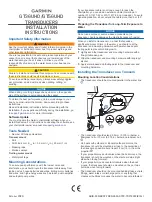
Hardware description
9
SLLU216 – July 2019
Copyright © 2019, Texas Instruments Incorporated
SPI to CAN FD SBC + LIN Transceiver BoosterPack User's Guide
2.3.1
LIN Bus DB-9 Connector (J7)
The LIN bus signal is accessible through an unused pin (pin 8) of the DB-9 connector J7, which follows
the industry-standard CAN pin mapping. This mapping allows for easy integration into an existing system.
The external supply voltage V
BAT
, ground, and connector shield ground connections are also included in
the connector J7. The LIN bus signal has also been included on header J8 along with the other CAN
signals allowing an additional connection or monitoring point.
To route the LIN bus signal to the DB-9 connector and header J8, place a shunt between the pins labeled
LIN and DB9 on jumper J4.
CAUTION
Pin 8 of the DB-9 connector pinout is considered reserved as an upgrade path
for future use and could be used for different purposes by other hardware. If the
BoosterPack is to be connected to other types of hardware, the compatibility of
pin 8 as well as all the other pins, should be checked for compatibility to avoid
the possibility of damage.
2.3.2
LIN Terminal Block (J5)
The LIN bus signal is accessible on the 2-pin terminal block J5. This is a convenient method for
connecting the BoosterPack to other hardware without the need for specific connectors and only requires
basic stripped twisted-pair wire. To route the LIN bus signal to the terminal block J5, place a shunt
between the the pins labeled LIN and TERM on jumper J4.
2.3.3
LIN Master/Slave Mode
The BoosterPack kit provides users with the ability to evaluate TI's TLINx02x-Q1 family of the single-
channel, LIN transceivers. The BoosterPack allows both master and slave mode applications to be
evaluated through the use of a single jumper (J3) that connects or disconnects the external 1-k
Ω
pullup
resistor and series diode required in master mode from the LIN bus. To configure the BoosterPack for
master mode, place a shunt on J3 to connect the external 1-k
Ω
resistor and series diode to the LIN bus
per the LIN specification. To configure the board for slave mode, remove the shunt on J3 to disconnect
the external 1-k
Ω
resistor and series diode from the LIN bus per the LIN specification.
2.3.4
LIN IO pins
The received data (RXD) pin is an open-drain output that requires an external pull-up resistor (R6) to the
MCU voltage rail. The BoosterPack uses the 3.3 V rail for the digital IO levels and includes a 10-k
Ω
resistor to 3.3 V. The enable (EN) control pin has an external 10-k
Ω
pull-down resistor (R5) to keep the
transceiver in Sleep Mode until this pin is driven to 3.3 V by the MCU to place it into Normal Mode. Non-
populated capacitor pads (C8 and C9) are also available on the TXD and RXD pins to accommodate a
variety of different tests that may require a capacitive load.
The BoosterPack also supports versions of the TLINx02x-Q1 device family with inhibit and wake features
which can be evaluated with a simple hardware assembly modification.
2.3.5
LIN TVS Diode (D7)
A SOD323 TVS diode footprint has been added to the BoosterPack and diodes installed to provide
maximum protection when used in environments that may not have proper ESD controls. However, the
use of these external diodes are considered optional and the TLIN2029-Q1 contains robust internal ESD
protection.
2.4
MCU interface (SPI/GPIO)
The following sections describe the features of the MCU/LaunchPAD interface










































